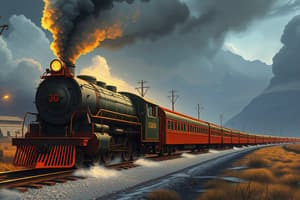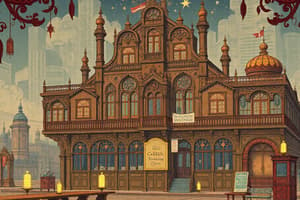Podcast
Questions and Answers
What is one of the main functions of a corporation?
What is one of the main functions of a corporation?
- To eliminate competition in the industry
- To limit shareholder liability (correct)
- To produce goods solely for individual owners
- To discourage the use of patents
What was one consequence of the Sherman Antitrust Act?
What was one consequence of the Sherman Antitrust Act?
- It provided legal support for labor unions
- It aimed to break up monopolistic practices (correct)
- It mandated government ownership of all industries
- It encouraged monopolies to flourish
How did labor unions help improve workers' rights in the late 19th century?
How did labor unions help improve workers' rights in the late 19th century?
- By encouraging more strikebreakers
- Through collective bargaining with employers (correct)
- By maintaining silence regarding workplace conditions
- Through government intervention without negotiation
What is nativism in the context of immigration?
What is nativism in the context of immigration?
What led to urbanization in the late 19th century?
What led to urbanization in the late 19th century?
Which of the following best describes the term 'strikebreakers'?
Which of the following best describes the term 'strikebreakers'?
How did the 'new immigrants' differ from their predecessors in the mid-1800s?
How did the 'new immigrants' differ from their predecessors in the mid-1800s?
What impact did laissez faire capitalism have on big businesses?
What impact did laissez faire capitalism have on big businesses?
Flashcards are hidden until you start studying
Study Notes
Industrialization and Big Business
- Patents protect inventions, promoting innovation in business.
- The assembly line improves efficiency by allowing workers to specialize in specific tasks.
- Corporations are legal entities that can own assets, enter contracts, and sell stock to raise capital.
- Stock represents ownership in a corporation, allowing investors to benefit from company profits.
- Monopolies occur when a single company dominates a market, potentially leading to higher prices and reduced quality for consumers.
- Trusts are arrangements where multiple companies work together to reduce competition.
- The free enterprise system allows businesses to operate with minimal government intervention, fostering competition.
- “Robber barons” refers to influential industrialists who gained wealth through exploitative practices, while “captains of industry” are seen as leaders who positively contributed to the economy.
- The Sherman Antitrust Act aimed to combat anti-competitive practices and promote fair competition.
- Vertical integration is the practice of controlling multiple levels of production, from raw materials to final products, increasing efficiency.
- Laissez-faire capitalism advocates minimal government regulation of businesses, promoting free-market growth essential for big business expansion.
- Andrew Carnegie, John D. Rockefeller, Cornelius Vanderbilt, and J.P. Morgan were key figures who established monopolies through aggressive business strategies in steel, oil, shipping, and finance, respectively.
Labor
- Labor unions are organizations that advocate for workers' rights and better working conditions.
- The American Federation of Labor (AFL) is a major labor union that focuses on skilled workers and collective bargaining.
- Collective bargaining is a negotiation process between employers and unions, helping workers secure better wages and conditions.
- Strikebreakers are workers hired to replace striking union members, helping companies maintain operations during labor disputes.
- Unions fought for improved workplace rights, including fair wages, safe working conditions, and reasonable hours.
- Unions were vital for laborers in the late 19th century as they united workers to challenge exploitation by large corporations.
- The government often sided with railroads during strikes, using military force to break up labor disruptions.
- Labor unions faced challenges in the late 1800s due to widespread public distrust, aggressive corporate opposition, and government intervention.
- Nativism led some Americans to fear labor unions, viewing them as radical and a threat to American values and jobs.
Immigration
- Immigrants in New York City primarily lived in impoverished neighborhoods or tenements, leading to overcrowded living conditions.
- “New immigrants” in the late 19th century, mainly from Southern and Eastern Europe, differed from earlier immigrants, who were predominantly from Northern and Western Europe.
- Nativists opposed immigration due to fears of job competition, cultural differences, and perceived threats to American identity.
- Nativists employed measures such as legislation and organized campaigns to restrict immigration.
Urbanization
- Urbanization is driven by industrial growth, attracting people to cities for job opportunities and improved living standards.
- Problems arising from urbanization include overcrowding, inadequate housing, pollution, and public health crises.
- Urbanization leads to increased population density, construction of public infrastructure, and heightened awareness of social issues such as poverty and disease.
Studying That Suits You
Use AI to generate personalized quizzes and flashcards to suit your learning preferences.




